Rapp battles EHS Brann for Barclays
Posted in: UncategorizedLONDON – Barclays is looking for a direct marketing agency to handle the launch of a reward scheme which is set to be introduced later in the year.
LONDON – Barclays is looking for a direct marketing agency to handle the launch of a reward scheme which is set to be introduced later in the year.
LONDON – The Engine Group is launching a specialist agency, Totem, that will work with clients in the business, corporate and financial sectors.
As a supporter of the National Advertising Benevolent Society (NABS), DDB was asked to contribute a submission to their annual calendar. ‘Swimsuit Edition’ was this year’s mandated theme.
Advertising Agency: DDB, Vancouver, Canada
Executive Creative Director: Alan Russell
Creative Director: Dean Lee/Cosmo Campbell
Art Director: Chris Moore
Copywriter: Jarrod Banadyga
Photographer: Philip Jarmain
Retoucher: The Orange Apple

The Minneapolis Star Tribune filed for bankruptcy after failed efforts from ads forced them to cease operations. They join the growing ranks of newspapers and publications rumored to be declaring bankrupt soon. Tribune Co., another newspaper company had also filed for Chapter 11 prior with practically the same case, declining ad revenues.
The Star Tribune, which competes with the St. Paul Pioneer Press in the Twin Cities of Minneapolis-St. Paul, listed assets of between $100 million and $500 million and debt of between $500 million and $1 billion in a Chapter 11 filing late yesterday in U.S. bankruptcy Court in Manhattan.
(Source) Bloomberg
MINNEAPOLIS (AdAge.com) — Fox's "American Idol" returned for its eighth season last night and the ratings results were a metaphor for the medium itself: "Idol," like network TV, still packs the most media impact, but faces accelerating audience attrition. Down 15% in the ad-centric adult 18-49 demographic from its season premiere last year and 26% from season six in 2006, the 11.7/28 rating and share still dominated the night, as Fox's nearest network competition was CBS, which delivered a second place 3.5/9. NBC was a close third with a 3.4/8, followed by ABC (2.3/6) and the CW (0.8/2).
Click Image To Enlarge
Advertising Agency: Equity, Dubai, UAE
Creative Director / Copywriter: Soni Ravindranath
Art Director: Satish Raju

NEW YORK (AdAge.com) — Coca-Cola has winnowed its European agencies from more than 20 to just four in an effort to realize marketing efficiencies and produce a more uniform message. The remaining shops on the Coca-Cola brand in Europe are Wieden & Kennedy, Amsterdam; Mother, London; McCann Erickson, Spain; and Sra. Rushmore, Madrid.
“Detective Stripes” é um policial que anda por aí mostrando suas roupas marcadas pelo desodorante. Com estética anos 1970, o site apresenta a versão masculina do Rexona Invisible, que promete não deixar manchas brancas.
A história do detetive é dividida em 5 capítulos, com depoimentos de diferentes personagens: Colleague, Thief, Cleaner, Barman e Shrink. Ao final de cada um deles você ganha presentinhos, como screensavers, papertoy, wallpaper e ringtones.
Baita produção e roteiro, apesar da interação limitada. A criação é da mexicana Grupo W.
| Via colmeia
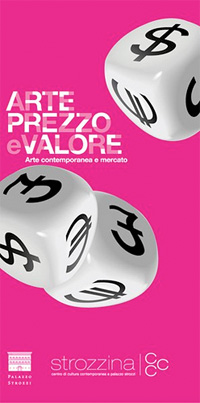 ART, PRICE AND VALUE – Contemporary Art and the Market (Part 1). The exhibition, which closed a few days ago at Strozzina – CCCS in Florence, investigated the increased links between contemporary art and the international market.
ART, PRICE AND VALUE – Contemporary Art and the Market (Part 1). The exhibition, which closed a few days ago at Strozzina – CCCS in Florence, investigated the increased links between contemporary art and the international market.
The contemporary art world has experienced transformations over the past few decades, it attracted attention and investors and turned into a non-stop party. But time has come for hangovers: collectors and sponsors’ enthusiasm has been shattered by the economic downturn. Speculations about what the new situation will entail are raging all over the contemporary art community.
An idea that pervades the various forecasts and analysis is that if the global financial crisis changes the rules and the players, it might also bring some positive corollaries. As the art critic Robert Hughes has argued, the appreciation of art has become too tainted by its association with bloated values (via). The crisis might force the contemporary art world to find alternatives to a money-centered situation which had blown out of proportion, invent new survival strategies and readjust the way we value art. I quite like this extract of an essay that Manuel Borja-Villel, Director of the Museo Nacional Centro de Arte Reina Sofía in Madrid wrote for El Pais: We didn’t realize that this creativity and radicality had become labels for consumption. We must reflect on where we are, what we want and where we are going and ask ourselves whether what we are looking for is an art that contributes to the public space, or on the opposite, whether what we are interested in is to create a new label to show off in parties.
Some would even add that there’s nothing better than a dire financial context to stimulate art and see new avant-gardes emerge. Maybe but i still hate the idea that artists have to suffer, drink their despair in absinthe and cut their ear in order to gain talent and respect.
Enough of my two-pence on the subject. Let’s get back to the exhibition with a couple of artworks:
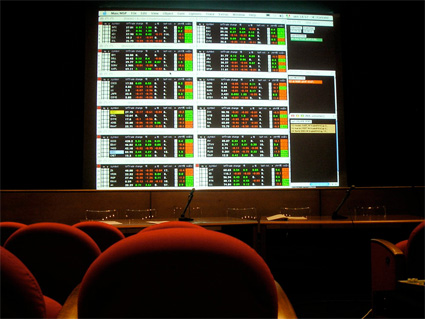
Fabio Cifariello Ciardi, a BID match, 2008, video site specific, courtesy the artist
Fabio Cifariello Ciardi‘s A BID Match is based NASDAQ Voices, an audiovisual installation that turns real time trading data over any day of trading on the NASDAQ Stock Market into sound compositions. A BID Match maps the performance of the share price of Sotheby’s and of the New York Stock Exchange. The term BID refers both to the bidding process at an auction and to the abbreviation BID for Sotheby’s at the New York Stock Exchange. The time span monitored was 15 September 2008, the first day of the auction of Damien Hirst at Sotheby’s. Surprisingly immune from any preoccupation about the financial markets that were crashing that very week, the auction outperformed the expectations of Sotheby’s.
Just pasting below a BBC report on the auction. In almost 2 minutes and 30 seconds they manage to repeat over and again words that relate to money but never comment on the artistic qualities of the work:
Pablo Helguera‘s Manual of Contemporary Art Style is a witty book that scrutinize the inner social workings of the contemporary art scene, and guides the readers through the the do’s and don’t of life in and around the art community.
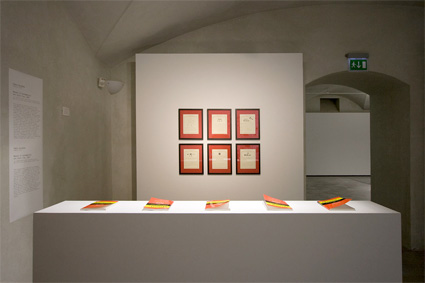
Manual of Contemporary Art Style Tips, 2007 (view of the exhibition room)
The Manual gives answers essential questions such as: Should one sleep with an artist whose work one does not like? How can one escape from a never-ending video installation while in the presence of others? How to cure the “festivalist syndrome”? How to use google as a curatorial tool? I’m going to order the book just for this other question: What should one say to close friends when they exhibit bad work?
You think that as a mere gallery visitor you are an outsider who doesn’t have to abide by the rules? Big mistake. You have duties and must adopt an adequate behaviour. Even the perfume you are wearing must show some respect to the art space.
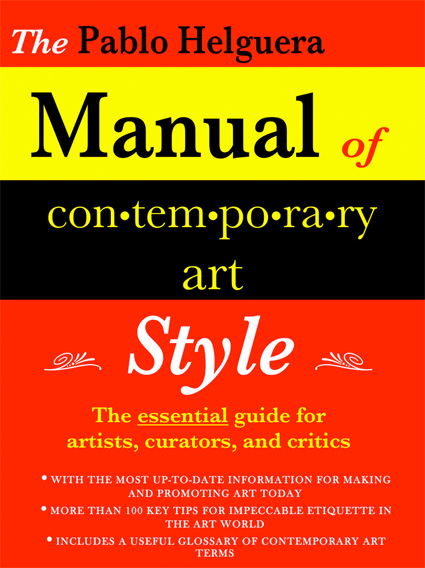
Manual of Contemporary Art Style Tips, 2007
I had a quick look through it. Despite its almost comical purpose and style, the book is shock full of recommendations that have more sense than folly. I kept catching myself thinking “That’s exactly like that!” Chapter after chapter, Helguera paints a portrait of a contemporary art scene constantly swaying between the need to cultivate an image of avant-guarde and non-conformism and the necessity to please the conservative art market that sustains them financially.
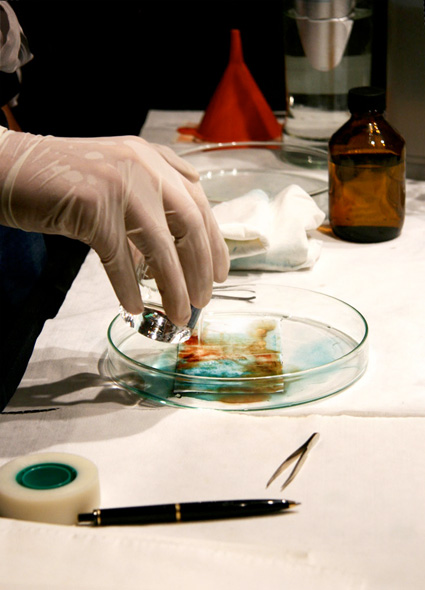
Untitled, 2008. Produced by CCCS, Florence and Galleria Franco Soffiantino, Turin
What turns an object into art? Where are the analogies between money and art? For the exhibition at the CCCS in Florence Cesare Pietroiusti covered a wall with 3000 one- and five-dollar bills previously treated with sulphuric acid and stamped on their back side. While it had lost its worth as a currency, each banknote had acquired the status of a unique work of art. The visitors were invited to take one of the bills, on the back side of which the following warning was stamped: “each monetary transaction involving this artwork will invalidate the signature of its author and consequently transform it into a fake”.
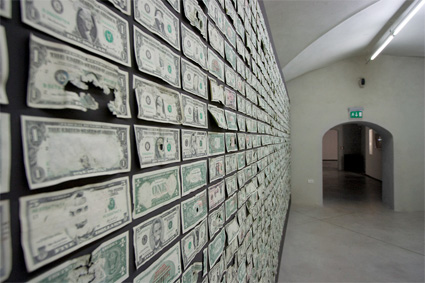
Untitled, 2008. Produced by CCCS, Florence and Galleria Franco Soffiantino, Turin
By inviting the audience to actively take part in this process in which Pietroiusti is preventing the individual artwork to be converted into money. Art becomes a non-monetary gift. The artist thereby undermines the logic of the art market which thrives on the idea that a work of art in not only a commodity saleable at a certain price, but that it may even generate a profit. By excluding the characteristics of an artwork as a convertible currency, he is revealing and removing one of the fundamentals of the art market.
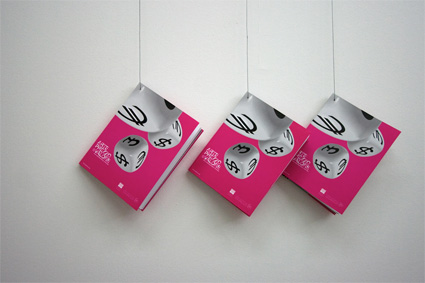
Untitled, 2008. Produced by CCCS, Florence and Galleria Franco Soffiantino, Turin
The exhibition closed a few days ago but you can explore its theme further in the catalog published in both english and italian.
All images Strozzina – CCCS.